Centaurus A
Centaurus A (also known as NGC 5128 or Caldwell 77) is a galaxy in the constellation of Centaurus. It was discovered in 1826 by Scottish astronomer James Dunlop from his home in Parramatta, in New South Wales, Australia. There is considerable debate in the literature regarding the galaxy's fundamental properties such as its Hubble type (lenticular galaxy or a giant elliptical galaxy)[9] and distance (10–16 million light-years).[2][3][4][5][6] NGC 5128 is one of the closest radio galaxies to Earth, so its active galactic nucleus has been extensively studied by professional astronomers.[12] The galaxy is also the fifth-brightest in the sky,[12] making it an ideal amateur astronomy target,[13] although the galaxy is only visible from low northern latitudes and the southern hemisphere.
| Centaurus A | |
|---|---|
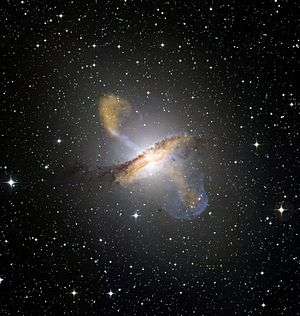 Centaurus A (NGC 5128) | |
| Observation data (J2000 epoch) | |
| Constellation | Centaurus |
| Right ascension | 13h 25m 27.6s[1] |
| Declination | −43° 01′ 09″[1] |
| Redshift | 547 ± 5 km/s[1] |
| Distance | 10–16 Mly (3–5 Mpc)[2][3][4][5][6] |
| Apparent magnitude (V) | 6.84[7][8] |
| Characteristics | |
| Type | S0 pec[1] or Ep[9] |
| Size | 60,000 ly[10] |
| Apparent size (V) | 25'.7 × 20'.0[1] |
| Notable features | Unusual dust lane |
| Other designations | |
| NGC 5128,[1] Arp 153,[1] PGC 46957,[1] 4U 1322–42,[11] Caldwell 77 | |
The center of the galaxy contains a supermassive black hole with a mass of 55 million solar masses,[14] which ejects a relativistic jet that is responsible for emissions in the X-ray and radio wavelengths. By taking radio observations of the jet separated by a decade, astronomers have determined that the inner parts of the jet are moving at about half of the speed of light. X-rays are produced farther out as the jet collides with surrounding gases, resulting in the creation of highly energetic particles. The X-ray jets of Centaurus A are thousands of light-years long, while the radio jets are over a million light-years long.[15]
Like other starburst galaxies, a collision is suspected to be responsible for the intense burst of star formation. Models have suggested that Centaurus A was a large elliptical galaxy that collided and merged with a smaller spiral galaxy.[16]
Observational history
NGC 5128 was discovered on 29 April 1826 by James Dunlop during a survey at the Parramatta Observatory.[17]
In 1847 John Herschel described the galaxy as "two semi-ovals of elliptically formed nebula appearing to be cut asunder and separated by a broad obscure band parallel to the larger axis of the nebula, in the midst of which a faint streak of light parallel to the sides of the cut appears."[18]
In 1949 John Gatenby Bolton, Bruce Slee and Gordon Stanley localized NGC 5128 as one of the first extragalactic radio sources.[19] Five years later, Walter Baade and Rudolph Minkowski suggested that the peculiar structure is the result of a merge event of a giant elliptical galaxy and a small spiral galaxy.[20] The first detection of X-ray emissions, using a sounding rocket, was performed in 1970.[21] In 1975–76 gamma-ray emissions from Centaurus A were observed through the atmospheric Cerenkov technique.[22]
The Einstein Observatory detected an X-ray jet emanating from the nucleus in 1979.[23] Ten years later, young blue stars were found along the central dust band with the Hubble Space Telescope.[24]
The Chandra X-ray Observatory identified in 1999 more than 200 new point sources.[25] Another space telescope, the Spitzer Space Telescope, found a parallelogram-shaped structure of dust in near infrared images of Centaurus A in 2006.[26]
Evidence of gamma emissions with very high energy (more than 100 GeV) was detected by the H.E.S.S-Observatorium in Namibia in 2009.[27]
The following year, Centaurus A was identified as a source of cosmic rays of highest energies, after years of observations by Pierre Auger Observatory.[28] In 2016 a review of data from Chandra and XMM-Newton, unusual high flares of energy were found in NGC 5128 and the galaxy NGC 4636. Jimmy Erwin of University of Alabama hypothesized the discovery as potentially a black hole in a yet unknown process or an intermediate-mass black hole.[29]
Morphology
Centaurus A may be described as having a peculiar morphology. As seen from Earth, the galaxy looks like a lenticular or elliptical galaxy with a superimposed dust lane.[30] The peculiarity of this galaxy was first identified in 1847 by John Herschel, and the galaxy was included in Halton Arp's Atlas of Peculiar Galaxies (published in 1966) as one of the best examples of a "disturbed" galaxy with dust absorption.[31] The galaxy's strange morphology is generally recognized as the result of a merger between two smaller galaxies.[32]
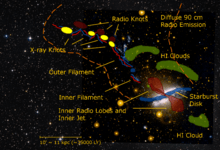
The bulge of this galaxy is composed mainly of evolved red stars.[30] The dusty disk, however, has been the site of more recent star formation;[12] over 100 star formation regions have been identified in the disk.[33]
Supernovae
Two supernovae have been detected in Centaurus A.[34] The first supernova, named SN 1986G, was discovered within the dark dust lane of the galaxy by R. Evans in 1986.[35] It was later identified as a Type Ia supernova,[36] which forms when a white dwarf's mass grows large enough to ignite carbon fusion in its center, touching off a runaway thermonuclear reaction, as may happen when a white dwarf in a binary star system strips gas away from the other star. SN 1986G was used to demonstrate that the spectra of type Ia supernovae are not all identical, and that type Ia supernovae may differ in the way that they change in brightness over time.[36]
The second supernova, dubbed SN2016adj,[37] was discovered by Backyard Observatory Supernova Search in February 2016 and was initially classified as a Type II supernova based on its H-alpha emission line.[38] [39] A subsequent classification found the spectrum best resembled the Type Ib core-collapse supernova 1999dn [40] (See Type Ib and Ic supernovae).
Distance
Distance estimates to Centaurus A established since the 1980s typically range between 3–5 Mpc.[2][3][4][5][6][41] Classical Cepheids discovered in the heavily obscured dust lane of Centaurus A yield a distance between ~3–3.5 Mpc, depending on the nature of the extinction law adopted and other considerations.[4][5] Mira variables[41] and Type II Cepheids[4][5] were also discovered in Centaurus A, the latter being rarely detected beyond the Local Group.[42] The distance to Centaurus A established from several indicators such as Mira variables and planetary nebulae favour a more distant value of ~3.8 Mpc.[9][6]
Nearby galaxies and galaxy group information
Centaurus A is at the center of one of two subgroups within the Centaurus A/M83 Group, a nearby group of galaxies.[43] Messier 83 (the Southern Pinwheel Galaxy) is at the center of the other subgroup. These two groups are sometimes identified as one group[44][45] and sometimes identified as two groups.[46] However, the galaxies around Centaurus A and the galaxies around M83 are physically close to each other, and both subgroups appear not to be moving relative to each other.[47] The Centaurus A/M83 Group is located in the Virgo Supercluster.
Observations
Radio waves
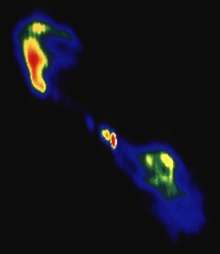
Visibility
_and_its_strange_globular_clusters.jpg)
Centaurus A is located approximately 4° north of Omega Centauri (a globular cluster visible with the naked eye).[13] Because the galaxy has a high surface brightness and relatively large angular size, it is an ideal target for amateur astronomy observations. The bright central bulge and dark dust lane are visible even in finderscopes and large binoculars,[13] and additional structure may be seen in larger telescopes.[13] Centaurus A is visible to the naked eye under exceptionally good conditions.[51]
Gallery

 Centaurus A
Centaurus A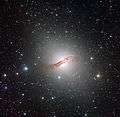 Image taken by the Wide Field Imager attached to the MPG/ESO 2.2-meter telescope at the La Silla Observatory
Image taken by the Wide Field Imager attached to the MPG/ESO 2.2-meter telescope at the La Silla Observatory Centaurus A halo
Centaurus A halo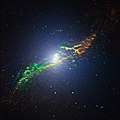 The radio galaxy Centaurus A, as seen by ALMA
The radio galaxy Centaurus A, as seen by ALMA The heavily obscured inner (barred?) spiral disk at 24 μm as shown by the Spitzer IR telescope
The heavily obscured inner (barred?) spiral disk at 24 μm as shown by the Spitzer IR telescope Chandra X-ray view of Cen A in X-rays showing one relativistic jet from the central black hole
Chandra X-ray view of Cen A in X-rays showing one relativistic jet from the central black hole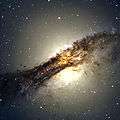
 "Hubble's panchromatic vision... reveals the vibrant glow of young, blue star clusters..."[53]
"Hubble's panchromatic vision... reveals the vibrant glow of young, blue star clusters..."[53] A Hubble Space Telescope (HST) image of the dust disk in front of the nucleus of Centaurus A. Credit: HST/NASA/ESA
A Hubble Space Telescope (HST) image of the dust disk in front of the nucleus of Centaurus A. Credit: HST/NASA/ESA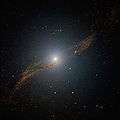 This image of the central parts of Centaurus A reveals the parallelogram-shaped remains of a smaller galaxy that was absorbed about 200 to 700 million years ago.
This image of the central parts of Centaurus A reveals the parallelogram-shaped remains of a smaller galaxy that was absorbed about 200 to 700 million years ago. A composite image showing the size of the radio glow from the galaxy Centaurus A in comparison to the full Moon
A composite image showing the size of the radio glow from the galaxy Centaurus A in comparison to the full Moon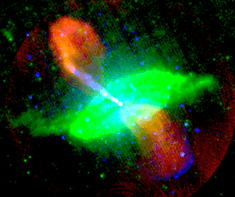 "False-colour image of Centaurus A, showing radio (red), 24-micrometre infrared (green) and 0.5–5 keV X-ray emission (blue)
"False-colour image of Centaurus A, showing radio (red), 24-micrometre infrared (green) and 0.5–5 keV X-ray emission (blue)- Central part of the galaxy
See also
- Messier 87 – a giant elliptical galaxy that is also a strong radio source
- NGC 1316 – a similar lenticular galaxy that is also a strong radio source
References
- "NASA/IPAC Extragalactic Database". Results for Centaurus A. Retrieved 6 December 2006.
- J. L. Tonry; A. Dressler; J. P. Blakeslee; E. A. Ajhar; et al. (2001). "The SBF Survey of Galaxy Distances. IV. SBF Magnitudes, Colors, and Distances". Astrophysical Journal. 546 (2): 681–693. arXiv:astro-ph/0011223. Bibcode:2001ApJ...546..681T. doi:10.1086/318301.
- "Distance Results for NGC 5128". NASA/IPAC Extragalactic Database. Retrieved 26 April 2010.
- Ferrarese Laura; Mould Jeremy R.; Stetson Peter B.; Tonry John L.; et al. (2007). "The Discovery of Cepheids and a Distance to NGC 5128". Astrophysical Journal. 654 (1): 186–218. arXiv:astro-ph/0605707. Bibcode:2007ApJ...654..186F. doi:10.1086/506612.
- Majaess, D. (2010). "The Cepheids of Centaurus A (NGC 5128) and Implications for H0". Acta Astronomica. 60 (2): 121. arXiv:1006.2458. Bibcode:2010AcA....60..121M.
- Harris, Gretchen L. H.; Rejkuba, Marina; Harris, William E. (2010). "The Distance to NGC 5128 (Centaurus A)". Publications of the Astronomical Society of Australia. 27 (4): 457–462. arXiv:0911.3180. Bibcode:2010PASA...27..457H. doi:10.1071/AS09061.
- "NAME Centaurus A". SIMBAD. Centre de données astronomiques de Strasbourg. Retrieved 29 November 2009.
- Armando, Gil de Paz; Boissier; Madore; Seibert; Boselli; et al. (2007). "The GALEX Ultraviolet Atlas of Nearby Galaxies". Astrophysical Journal Supplement. 173 (2): 185–255. arXiv:astro-ph/0606440. Bibcode:2007ApJS..173..185G. doi:10.1086/516636.
- Harris, Gretchen L. H. (2010). "NGC 5128: The Giant Beneath". Publications of the Astronomical Society of Australia. 27 (4): 475–481. arXiv:1004.4907. Bibcode:2010PASA...27..475H. doi:10.1071/AS09063.
- "APOD: 2012 April 4 – Centaurus A". apod.nasa.gov. Archived from the original on 3 October 2014.
- "UHURU4 – Uhuru Fourth (4U) Catalog". heasarc.gsfc.nasa.gov.
- F. P. Israel (1998). "Centaurus A – NGC 5128". Astronomy and Astrophysics Review. 8 (4): 237–278. arXiv:astro-ph/9811051. Bibcode:1998A&ARv...8..237I. doi:10.1007/s001590050011.
- D. J. Eicher (1988). The Universe from Your Backyard. Cambridge: Cambridge University Press. ISBN 978-0-521-36299-3.
- "Radio Telescopes Capture Best-Ever Snapshot of Black Hole Jets". NASA. Retrieved 2 October 2012.
- Nemiroff, R.; Bonnell, J., eds. (13 April 2011). "Centaurus Radio Jets Rising". Astronomy Picture of the Day. NASA. Retrieved 16 April 2011.
- Quillen, A. C.; Brookes, M. H.; Keene, J.; Stern, D.; Lawrence, C. R.; Werner, M. W. (2006). "Spitzer Observations of the Dusty Warped Disk of Centaurus A". Astrophysical Journal. 645 (2): 1092–1101. arXiv:astro-ph/0601135. Bibcode:2006ApJ...645.1092Q. doi:10.1086/504418.
- Peter Robertson; Glen Cozens; Wayne Orchiston; Bruce Slee; Harry Wendt (1 January 2010). "Early Australian Optical and Radio Observations of Centaurus A". Publications of the Astronomical Society of Australia. 27 (4): 402–430. arXiv:1012.5137. Bibcode:2010PASA...27..402R. doi:10.1071/AS09071. ISSN 1323-3580.
- John Herschel (1849). "Outlines of Astronomy": 602. Cite journal requires
|journal=(help) - J. G. Bolton; G. J. Stanley; O. B. Slee (1949). "Positions of Three Discrete Sources of Galactic Radio-Frequency Radiation". Nature. 164 (4159): 101–102. Bibcode:1949Natur.164..101B. doi:10.1038/164101b0.
- Baade, W.; Minkowski, R. (1 January 1954). "On the Identification of Radio Sources". Astrophysical Journal. 119: 215. Bibcode:1954ApJ...119..215B. doi:10.1086/145813 – via NASA ADS.
- C. S. Bowyer; M. Lampton; J. Mack; F. de Mendonca (1970). "Detection of X-Ray Emission from 3C 273 and NGC 5128". Astrophysical Journal. 161: L1. Bibcode:1970ApJ...161L...1B. doi:10.1086/180559.
- Grindlay, J. E.; Helmken, H. F.; Brown, R. H.; Davis, J.; Allen, L. R. (1 April 1975). "Evidence for the detection of gamma rays from Centaurus A at gamma-ray energies above 300 GeV". Astrophysical Journal Letters. 197: L9–L12NASA ADS. Bibcode:1975ApJ...197L...9G. doi:10.1086/181764.
- E. J. Schreier; E. Feigelson; J. Delvaille; R. Giacconi; D. A. Schwartz (1979). "EINSTEIN Observations of The X-Ray Structure of Centaurus A: Evidence For The Radio-Lobe Energy Source". Astrophysical Journal, Part 2. 234: 39–43. Bibcode:1979ApJ...234L..39S. doi:10.1086/183105.
- "HubbleSite – NewsCenter – Hubble Provides Multiple Views of How to Feed a Black Hole (05/14/1998) – Background Info". Retrieved 14 October 2015.
- R. P. Kraft; J. M. Kregenow; W. R. Forman; C. Jones; S. S. Murray (20 October 2001). "Chandra Observations of the X‐Ray Point Source Population in Centaurus A". Astrophysical Journal. 560 (2): 675–688. Bibcode:2001ApJ...560..675K. doi:10.1086/323056.
- Alice C. Quillen; Mairi H. Brookes; Jocelyn Keene; Daniel Stern; Charles R. Lawrence (10 July 2006). "Spitzer Observations of the Dusty Warped Disk of Centaurus A". Astrophysical Journal. 645 Nummer = 2 (2): 1092–1101. arXiv:astro-ph/0601135. Bibcode:2006ApJ...645.1092Q. doi:10.1086/504418.
- F. Aharonian; A. G. Akhperjanian; G. Anton; U. Barres de Almeida; A. R. Bazer-Bachi (10 April 2009). "DISCOVERY OF VERY HIGH ENERGY γ-RAY EMISSION FROM CENTAURUS A WITH H.E.S.S.". Astrophysical Journal. 695 (1): L40–L44. arXiv:0903.1582. Bibcode:2009ApJ...695L..40A. doi:10.1088/0004-637x/695/1/l40.
- J. Abraham; P. Abreu; M. Aglietta; C. Aguirre; D. Allard (1 April 2008). "Correlation of the highest-energy cosmic rays with the positions of nearby active galactic nuclei". Astroparticle Physics. 29 (3): 188–204. arXiv:0712.2843. Bibcode:2008APh....29..188P. doi:10.1016/j.astropartphys.2008.01.002.
- "Deep space X: Mysterious flashes discovered beyond Milky Way". RT International. 20 October 2016. Retrieved 22 October 2016.
- A. Sandage; J. Bedke (1994). Carnegie Atlas of Galaxies. Washington, D.C.: Carnegie Institution of Washington. ISBN 978-0-87279-667-6.
- H. Arp (1966). "Atlas of Peculiar Galaxies". Astrophysical Journal Supplement. 14: 1–20. Bibcode:1966ApJS...14....1A. doi:10.1086/190147.
- W. Baade; R. Minkowski (1954). "On the Identification of Radio Sources". Astrophysical Journal. 119: 215–231. Bibcode:1954ApJ...119..215B. doi:10.1086/145813.
- P. W. Hodge; R. C. Kennicutt Jr. (1982). "An atlas of H II regions in 125 galaxies". Astrophysical Journal. 88: 296–328. Bibcode:1983AJ.....88..296H. doi:10.1086/113318.
- "NASA/IPAC Extragalactic Database". Results for extended name search on Centaurus A. Retrieved 7 March 2007.
- R. Evans; R. H. McNaught; C. Humphries (1986). "Supernova 1986G in NGC 5128". IAU Circular. 4208: 1. Bibcode:1986IAUC.4208....1E.
- M. M. Phillips; A. C. Phillips; S. R. Heathcote; V. M. Blanco; et al. (1987). "The type 1a supernova 1986G in NGC 5128 – Optical photometry and spectra". Publications of the Astronomical Society of the Pacific. 99: 592–605. Bibcode:1987PASP...99..592P. doi:10.1086/132020.
- "Supernova SN 2016adj in the peculiar galaxy NGC 5128 ("Centaurus A") – 9 Feb. 2016 – The Virtual Telescope Project 2.0". 9 February 2016.
- "ATel #8651: Bright PSN in NGC5128 (Centaurus A) Discovered By Backyard Observatory Supernova Search (BOSS)". ATel.
- "ATel #8655: Tentative Spectroscopic Classification of Bright PSN in NGC 5128 (Centaurus A)". ATel.
- "ATel #8657: CSP Spectroscopic Classification of AT 2016adj in NGC 5128 (Centaurus A)". ATel.
- Rejkuba, M. (2004). "The distance to the giant elliptical galaxy NGC 5128". Astronomy and Astrophysics. 413 (3): 903–912. arXiv:astro-ph/0310639. Bibcode:2004A&A...413..903R. doi:10.1051/0004-6361:20034031.
- Majaess, D.; Turner, D.; Lane, D. (2009). "Type II Cepheids as Extragalactic Distance Candles". Acta Astronomica. 59 (4): 403. arXiv:0909.0181. Bibcode:2009AcA....59..403M.
- I. D. Karachentsev; M. E. Sharina; A. E. Dolphin; E. K. Grebel; et al. (2002). "New distances to galaxies in the Centaurus A group". Astronomy and Astrophysics. 385 (1): 21–31. Bibcode:2002A&A...385...21K. doi:10.1051/0004-6361:20020042.
- R. B. Tully (1988). Nearby Galaxies Catalog. Cambridge: Cambridge University Press. ISBN 978-0-521-35299-4.
- P. Fouque; E. Gourgoulhon; P. Chamaraux; G. Paturel (1992). "Groups of galaxies within 80 Mpc. II – The catalogue of groups and group members". Astronomy and Astrophysics Supplement. 93: 211–233. Bibcode:1992A&AS...93..211F.
- A. Garcia (1993). "General study of group membership. II – Determination of nearby groups". Astronomy and Astrophysics Supplement. 100: 47–90. Bibcode:1993A&AS..100...47G.
- I. D. Karachentsev (2005). "The Local Group and Other Neighboring Galaxy Groups". Astronomical Journal. 129 (1): 178–188. arXiv:astro-ph/0410065. Bibcode:2005AJ....129..178K. doi:10.1086/426368.
- Roopesh Ojha; M. Kadler; M. Böck; R. Booth; M. S. Dutka (30 December 2009). "TANAMI: Milliarcsecond Resolution Observations of Extragalactic Gamma-ray Sources". 2009 Fermi Symposium. arXiv:1001.0059. Bibcode:2010arXiv1001.0059O.
- Inner Radio Lobes of Centaurus A (NGC 5128). Archived 16 September 2016 at the Wayback Machine
- "The Dark Side of Star Clusters". Retrieved 12 June 2015.
- "Aintno Catalog". astronomy-mall.com.
- "SPECULOOS Southern Observatory". www.eso.org. Retrieved 29 July 2019.
- "Firestorm of Star Birth in Galaxy Centaurus A". NASA. Retrieved 27 September 2012.
Sources
- STScI. Hubble Provides Multiple Views of How to Feed a Black Hole. Press release: Space Telescope Science Institute. 14 March 1998.
- Chandra X-Ray Observatory Photo Album Centaurus A Jet
External links
| Wikimedia Commons has media related to Centaurus A. |
- Sarka Wykes Centaurus A project
- SEDS: Peculiar Galaxy NGC 5128
- ESA/Hubble images of Centaurus A
- NASA's APOD: X-Rays from an Active Galaxy (July 5, 2003)
- NASA's APOD: The Galaxy Within Centaurus A (March 4, 2006)
- NASA's APOD: Centaurus A (July 12, 2018)
- High-resolution image of Centaurus A showing the discrete elements of galactic core
- Centaurus A at UniverseToday.com
- NGC5128 Centaurus A
- NGC 5128 at DOCdb (Deep Sky Observer's Companion)
- Centaurus A on WikiSky: DSS2, SDSS, GALEX, IRAS, Hydrogen α, X-Ray, Astrophoto, Sky Map, Articles and images
- Centaurus A at Constellation Guide
